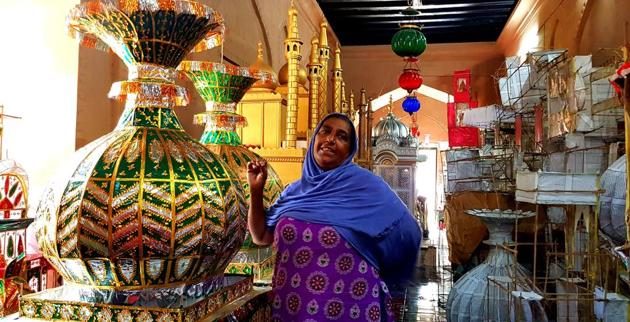Lucknow: Tazia makers give finishing touches to their work as Moharram approaches
A fusion of solemnity, dedication and exquisite craftsmanship is on display as tazia-makers race against time to complete their work at Rauza-e-Kazmain in old Lucknow on Monday, two days before the Islamic month of Moharram beginning on September 12.
A fusion of solemnity, dedication and exquisite craftsmanship is on display as tazia-makers race against time to complete their work at Rauza-e-Kazmain in old Lucknow on Monday, two days before the Islamic month of Moharram beginning on September 12.

The grand, double-storey gateway that leads to the Nawabi era structure in the densely populated Saadatganj area is packed with makeshift shops displaying colourful ‘tazias’, a replica of Imam Hussain’s mausoleum in Iraq.
Inside, several people are busy erecting makeshift shops for the convenience of those who will arrive to buy the tazias, the prices of which range from ₹500 to ₹10,000 each.
Munni Begum, a traditional tazia maker and her family is at work at the rear of the 19th century structure, which is said to be a replica of the tomb of Imam Musa Kazim and his grandson, the ninth Imam Mohammad Taqui of Khorasan in Iran.
“We are running late this time. There are three more tazias left to be completed,” says Munni Begum, who is in her late forties, while placing glitter carefully on a semi-finished tazia made of bamboo shavings and cardboard.
She says making tazias is her ancestral trade and hers is perhaps the third generation carrying forward the family legacy.
“I still remember my mother and grandmother making tazias. In fact, I learnt the art from them. But its preparation is not as easy as it seems. Each one of these (tazias) is an outcome of relentless efforts by all my family members,” says Begum, pointing to around 70 finished tazias, their height ranging from 10 inches to 8 metres.
The preparations began months ahead of Muharram.
“All members in a family have a different role to play. The men make the frame using bamboo shavings,” says Mohammed Saeed, a family member of Munni Begum.
“Only a trained and knowledgeable craftsman can prepare a tazia as it has to look like the mausoleum of Imam Hussain. One has to be careful,” Saeed adds.
Once the frame, either of bamboo, cardboard or empty cigarette boxes, is ready, the other family members take up the remaining work.
“The women ensure the framework is well covered with rough paper, followed by a coating of colourful papers. Children make sure they use the glitter to decorate the tazia,” he says.

Tazia-making this year got delayed due to a delay in procuring a loan from a local money lender, he says.
“We solely depend upon the income from selling tazias. We have to take loans from local money lenders to carry out the work every year. This year, the money lender delayed the funds. With the prices of raw material sky rocketing, it’s really becoming difficult for us to do our work,” he adds.
Like Saeed, there are around 150 families involved in tazia making in the state capital. “We believe it’s a dying art and the government is a mute spectator,” says Mohammed Shahansha, another traditional tazia maker from Kazmain.
“Until two decades back, many families in Faizabad, Kanpur, Agra, Moradabad and other districts were involved in tazia-making. But over the years, their income reduced and the prices of raw material increased drastically, forcing many to give up the ancestral craft,” Saeed says.
Meer Jafar Abdullah, member of a royal family of Awadh, says during Muharram, Shias keep tazias at their respective imambaras in their houses. The tazias have to brought a day before Muharram begins.
“Those who do not have enough space, often use a small portion of the house to keep tazias, commemorating the martyrdom of Imam Hussain in the battle of Karbala,” says Abdullah.

“Mostly, the tazias are buried on the 10th day of Muharram. Some families bury them on Chehellum, the 40th day of the martyrdom of Imam Hussein. Some bury it on the last day of Muharram,” Abdullah says.
In Lucknow, Shias bury the tazias in Tal Katora Karbala, in Purana Najaf and Kala Imambada (opposite Ghantaghar in old Lucknow). The Sunnis bury tazias at Phool Katora in the Mahanagar area of Lucknow.




